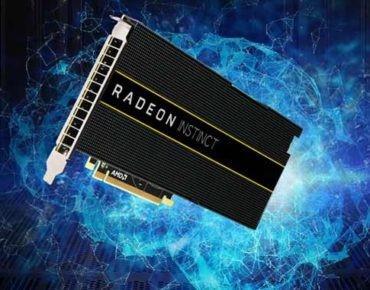#Radeon Instinct MI6
Explore tagged Tumblr posts
Text
SC17, AMD Radeon Instinct Is Shining Beside EPYC CPUs In High-Performance Platforms
New Post has been published on https://www.ultragamerz.com/sc17-amd-radeon-instinct-is-shining-beside-epyc-cpus-in-high-performance-platforms/
SC17, AMD Radeon Instinct Is Shining Beside EPYC CPUs In High-Performance Platforms

00
SC17, AMD Radeon Instinct Is Shining Beside EPYC CPUs In High-Performance Platforms
Machine Intelligence & Deep Learning Neural Network Training is basically the main goal of the AMD Instinct project. it has not yet release an actual project but it is targeting the Training techniques used today on neural networks in machine intelligence and deep learning. Applications in data centers have become very complex and require the handling of massive amounts of data when training those networks to recognize patterns within that data. This area is also becoming an interest for Nvidia recently and they have been working with the new 12nm Volta platform for huge data loads and AI tech needs. This kind of data processing requires lots of floating point computation spread across many cores like EPYC has, and traditional CPUs can’t handle this type of computation as efficient and as fast as the current multi stream GPUs handle it. What can take CPUs weeks to compute, can be handled in days with the use of GPUs. The Radeon Instinct MI25, is now combined with AMD’s new Epyc server processors and AMD ROCm open software platform, deliver performance needed for machine intelligence and deep learning applications.
Radeon Instinct performance running with 4,096 stream processors; along with its High Bandwidth Cache (HBC) and controller and 16GB of high-bandwidth HBM2 memory, The MI25 accelerator, based on AMD’s Next-Gen “Vega” architecture with the what AMD Calls it “the world’s most advanced memory architecture”, is optimized for handling large sets of data.
Radeon instinct mi25 credit AMD
Radeon instinct mi25 credit AMD
Tags: Technology, pc hardware, Radeon instinct mi25, AMD Radeon instinct mi25, Amd instinct mi25, vega, Radeon Instinct MI25, Radeon Instinct MI8, Radeon Instinct MI6, sc17, sc17 radeon instinct
#Amd instinct mi25#AMD Radeon instinct mi25#Pc hardware#Radeon instinct mi25#Radeon instinct mi25 credit AMD#Radeon Instinct MI6#Radeon Instinct MI8#sc17#sc17 radeon instinct#technology#Vega#Gaming hardware#Gaming News#Technology
0 notes
Photo

AMD lanza sus aceleradores Radeon Instinct
Esta nueva línea de aceleradores de servidor de GPU Radeon Instinct MI25, Radeon Instinct MI8 y Radeon Instinct MI6 que junto con la plataforma de software abierto de AMD ROCm 1.6, ayudarán al Deep Learning e inteligencia artificial.
0 notes
Text
AMD acelera el ecosistema de HPC y Deep Learning
AMD acelera el ecosistema de HPC y Deep Learning
AMD está lanzando una nueva era en los cómputos instintivos con sus aceleradores Radeon Instinct, que pronto serán enviados a los socios para alimentar sus soluciones HPC y Deep Learning.
Con la primera vista previa en diciembre de 2016, esta nueva línea de aceleradores de servidor de GPU -Radeon Instinct MI25, Radeon Instinct MI8 y Radeon Instinct MI6 – junto con la plataforma de software…
View On WordPress
0 notes
Text
AMD presenta Radeon Instinct, nuevas capacidades de Inteligencia Artificial sin precedentes
AMD presenta Radeon Instinct, nuevas capacidades de Inteligencia Artificial sin precedentes
Mostrada por primera vez en diciembre de 2016, esta nueva línea de de aceleradores de GPU para servidores – Radeon Instinct™ MI25, Radeon Instinct MI8 y Radeon Instinct MI6 – junto con la plataforma de software abierta ROCm 1.6 de AMD, ayudará a aumentar drásticamente el rendimiento, la eficiencia y la facilidad de implementación, acelerando a través de la inferencia de aprendizaje profundo y el…
View On WordPress
0 notes